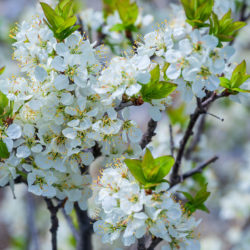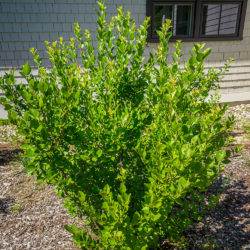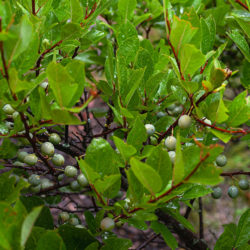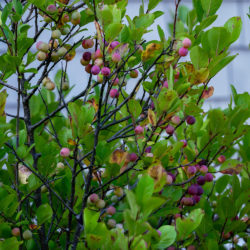Etymology
Prunus is Latin for plum tree; maritima in Latin means “of or pertaining to the sea”
Native Habitat
Sandy soil along or near the coast.
Garden Uses
Given the dependably profuse bloom of snowy white flowers and the ability to survive in low nutrient, droughty, and salt affected soils, the beach plum has gained value as an ornamental especially for problem sites. This shrub is a welcome addition to an edible landscape for years of good fruit production.
Overview
Beach plum is a rounded, densely branching, suckering shrub growing 6 ft. tall or more. It is often found in dunes on coastal beaches, meadows and fields growing in dense thickets. Although fairly common in most of New England, it is somewhat rare in Maine primarily due to the fact that its preferred beachfront habitat is becoming scarce as a result of development.
Leaves and Stems
The oblong leaves are dark green and glossy. The leaf blade is simple, has finely toothed edges, and at maturity is hairy or velvety beneath. The leaves generally drop off in the winter, although some may wither and persist. Beach plum is a shrub typically growing with several stems emerging from the same base, but can be trained as a single stemmed tree. The bark is thin and smooth and the twigs are reddish-brown, gray or purple. As the plant ages, the bark becomes darker and rougher. There are horizontal bands of lenticels (pores) along the stems.
Flowers
The flowers are 5-petaled, white, single or double and occur singly or in small clusters before the leaves emerge from April through June. The immaculate white of the flowers develop a pinkish hue upon successful pollination usually achieved through the service of wild bees.
Fruit/Seed
Fruits, which ripen in August and early September, are ½- to ¾-inch wide and range in color from purplish-black to red or rarely yellow. The fruits are drupes, containing a single egg-shaped seed.
Wildlife Associates
The late summer ripening of beach plum fruit provides a food source for a variety of many birds and other wildlife in addition to humans. The early bloom set of beach plum is a beneficial food source for native bees. Parasitoid wasps, antlions, hoverflies, greenhead flies and mosquitos are all commonly found nectar feeders. Tree hoppers, leaf hoppers, plant bugs and leaf beetles are common herbivore visitors of the maritime thickets. The dense thickets formed by beach plum provide protective habitat for birds and small mammals. The partially wilted foliage contains hydrocyanic acid, which has been known to kill livestock that have browsed upon it.
Propagation
Plants may be rooted from dormant hardwood, softwood, semi-hardwood, or root cuttings. Semi-hardwood and softwood cuttings taken in summer root easiest. If germinating by seed, cold stratification is necessary.
Ethnobotanical Uses
The seeds of beach plum contain poisonous substances and should never be eaten. Beach plums are most often grown commercially to make jam.
Garden Location
Library Garden (see garden map)
Sources
Lady Bird Johnson Wildflower Center
Maine Department of Agriculture Conservation and Forestry
Restoring The Landscape with Native Plants
Plant Profile by Kathy Kling






